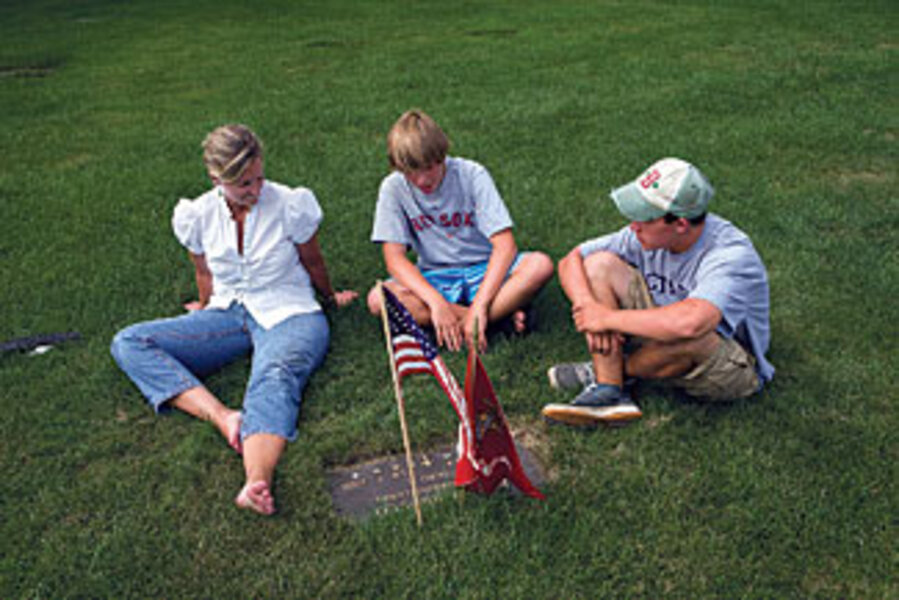Preventing suicides in the military
Loading...
| Newbury, Mass.
When John Ruocco, a Marine Corps major, committed suicide after a deployment in Iraq, his wife, Kim, didn't hide from the issue.
Instead, she read about it: books by mothers who had lost children to suicide, by people who had spent their careers studying suicide – anything to help her understand the terrible event that had so irrevocably altered her family. She searched her memory of their 23 years as sweethearts and spouses, trying to figure out how the unthinkable had become possible.
That kind of scrutiny sometimes can intensify sorrow, not lighten it. But through her grief, Mrs. Ruocco, now manager of suicide outreach and education programs for the nonprofit Tragedy Assistance Program for Survivors (TAPS), has quietly become an important figure in the effort to respond to suicides by military personnel.
"The experience of living through a loss to suicide raises question after question for the survivor," says Cmdr. Aaron Werbel, manager of the Marine Corps Suicide Prevention Program (MCSPP). "But through that – in Kim's larger efforts in suicide prevention and in her work with the Marine Corps – her work is helping to save other lives."
As the wars in Iraq and Afghanistan continue, so, too, do military suicides. This year, the MCSPP counted 34 suspected suicides among active duty marines from January to July. It recorded 42 suicides in the same group for all of 2008. The US Army lists 96 reported active-duty suicides for January to July 2009, up from 79 from January to July 2008.
Ruocco, who lives in Newbury, has told her story to military personnel around the country, encouraging individuals to seek help. She has also become a support to survivors of suicide – family members who may suddenly be crushed by grief, rejection, guilt, and shame.
"When many people would have slammed the door shut on the world and hunkered down with their grief, Kim has left the door open," says Bonnie Carroll, the founder of TAPS. "She has allowed others to learn from her experience as a survivor and a caregiver."
"Suicide is very complicated; every individual case of suicide is different," Ruocco says. "It's important to decrease the stigma attached to suicide by the military and to offer services to support both troops and survivors."
Ruocco, who holds a master's degree in social work, reviewed her husband's personnel files. She found only outstanding reviews. But as she thought about it more, she found signs: For example, the helicopter pilot had been rattled by a number of fatal flight accidents in his unit during duty in North Carolina in the 1990s.
While commanding a helicopter squadron in Iraq in 2004, he again grew troubled. He told Kim that he felt disconnected from the family, that he had difficulty flying, and that he could no longer find beauty in the world. His habits changed: He stopped attending church, and he sent the family just two letters during his six-month deployment.
Ruocco recounts the next weeks with heartbreaking precision. In early February 2005, the family called John, a longtime New England Patriots fan, to celebrate the team's win in the Super Bowl. He hadn't watched the game, he said. Kim asked him outright if he was thinking of killing himself. He said he would never do that, not to her and their two boys.
Desperate, Kim took a red-eye flight to California, where John was deployed. The next day, two members of John's squadron found him dead in his hotel room. He had been scheduled to come home that Thursday.
"I was in a fog for those first two years," Ruocco says. Suicide is like a jigsaw puzzle whose pieces have been scattered, she says. "Some pieces will never be found."
Today, Ruocco raises her two sons and handles her work with gentle humor and resolve. By noon on a warm late summer Sunday, she had spent hours on the phone with three survivors who had called TAPS in the wake of suicides. Later that month she flew to a speaking engagement at Fort Hood, Texas.
Since 2007, she has been invited to speak to several Marine Corps and National Guard units, and will speak to as many as 2,500 marines in San Diego later this year.
Ruocco has also achieved success in numerous private, sensitive conversations with individual soldiers. She was able to help a pilot through a situation quite similar to her husband's, she says.
Mary Gallagher met Ruocco after her own husband, Marine Corps Gunnery Sgt. James F. Gallagher, took his life in 2006, after serving in Iraq.
"I felt alone until Kim and TAPS came into my life," Mrs. Gallagher says. "Never in a million years would I have been able to do what I do now without her." Gallagher now serves as a mentor to suicide survivors and works for Hope for the Warriors, a nonprofit group committed to assisting wounded veterans.
Advocating for suicide prevention in the military has been a challenge, Ruocco says. She remembers a sergeant telling her, after one of her first presentations about suicide prevention, "I know my men better than you, ma'am."
Traditionally, military culture attaches a stigma of weakness to those harboring suicidal thoughts. Until that is changed, it will stand as a barrier to service personnel getting needed counseling, Ruocco says. Both she and Gallagher say they believe their husbands feared their careers would have been damaged had they sought help.
Ruocco has collaborated with the MCSPP to produce an innovative video that offers accounts from suicide survivors. "In my opinion, the insight of survivors is absolutely critical to the success of suicide prevention in the armed forces," Werbel says.
"Survivors are detectives," Ruocco adds. "My husband had excellent performance reviews. But if you ask me and his family, we can set the scene for you." r





